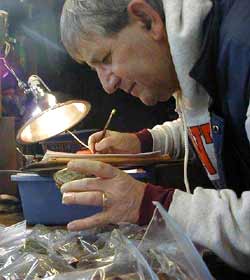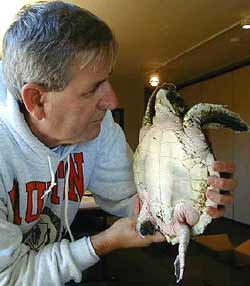 |

 on Lewis, a retired senior executive, is a liberal arts–educated political scientist who now applies his talents to understand the secret lives of the Outer Cape’s wild animals. Known as the Turtleman of Wellfleet Bay, Don devotes himself to saving the threatened diamondback terrapin, rescuing sea turtles from the fall freeze, and helping out any turtle, marine critter, or Cape wildlife in distress. As a full-time volunteer with the Massachusetts Audubon Society’s Wellfleet Bay Wildlife Sanctuary, he leads a dedicated team of researchers and volunteers in the Sanctuary’s twenty-two-year continuous program of terrapin research and conservation in the “Land of Ooze.” He also volunteers extensively with the Cape Cod Marine Mammal Stranding Network and the U.S. Humane Society’s Cape Wildlife Center. Each summer in late June, Don conducts a turtle and terrapin field school as part of Welfleet Bay’s Summer Field Schools for any interested participants who are willing to get down and dirty playing in the mud, and from May through October he leads frequent public orientation programs on terrapins and their habitat. For the Wellfleet Bay Wildlife Sanctuary’s summer 2002 field programs and lectures related to terrapins, click here. on Lewis, a retired senior executive, is a liberal arts–educated political scientist who now applies his talents to understand the secret lives of the Outer Cape’s wild animals. Known as the Turtleman of Wellfleet Bay, Don devotes himself to saving the threatened diamondback terrapin, rescuing sea turtles from the fall freeze, and helping out any turtle, marine critter, or Cape wildlife in distress. As a full-time volunteer with the Massachusetts Audubon Society’s Wellfleet Bay Wildlife Sanctuary, he leads a dedicated team of researchers and volunteers in the Sanctuary’s twenty-two-year continuous program of terrapin research and conservation in the “Land of Ooze.” He also volunteers extensively with the Cape Cod Marine Mammal Stranding Network and the U.S. Humane Society’s Cape Wildlife Center. Each summer in late June, Don conducts a turtle and terrapin field school as part of Welfleet Bay’s Summer Field Schools for any interested participants who are willing to get down and dirty playing in the mud, and from May through October he leads frequent public orientation programs on terrapins and their habitat. For the Wellfleet Bay Wildlife Sanctuary’s summer 2002 field programs and lectures related to terrapins, click here.
 |

Don’s adventures have been chronicled in regional and national media, as well as documented in a real-time photo-diary on this site (see links below). His most recent terrapin articles have appeared in Conservation Perspectives (of the Massachusetts Society for Conservation Biology) and the Turtle & Tortoise Newsletter; his original photographs and writings have been featured in National Geographic On-Line, the Environmental News Network, The Boston Globe Magazine, The Cape Cod Times and most of the Cape’s publications, and many others.
In the main, Don’s principal role in his retired afterlife is being the voice for Cape Cod’s embattled turtle population. His answer to the question, Why turtles?: “Because when you’re retired and looking for a research target, you ought to pick a critter you have a reasonable chance of catching.” In reality, though, the diamondback terrapin is the perfect model for assessing the impact of human development and other habitat altering activities within the fragile salt marsh environment. And, as a state-listed species, when such disturbances are recognized and documented, effective policies can be enforced to mitigate their impact.
Background and Research

 The northern diamondback terrapin, Malaclemys terrapin terrapin, occupies a unique niche in Wellfleet Harbor, living year-round in its rich estuarine system of rivers, creeks, coves, bays, and marshes (see diamondback terrapin fact sheet). While this subspecies can be found from Cape Hatteras to Cape Cod, Wellfleet marks its absolute northern limit, subject to severe climatic variations as well as the steady advance of human activity into its once secluded salt marsh habitat. Observing an animal at the extreme edge of its range serves as an important bellwether to monitor the health of the ecosystem. Massachusetts lists the diamondback terrapin as a threatened species and recognizing its signal role within the harbor environment, Massachusetts Audubon’s Wellfleet Bay Wildlife Sanctuary (see Wellfleet Bay on map of Cape Cod, right; click to enlarge) has organized research studies of terrapins since 1980 with informal observations stretching back a quarter century.
The northern diamondback terrapin, Malaclemys terrapin terrapin, occupies a unique niche in Wellfleet Harbor, living year-round in its rich estuarine system of rivers, creeks, coves, bays, and marshes (see diamondback terrapin fact sheet). While this subspecies can be found from Cape Hatteras to Cape Cod, Wellfleet marks its absolute northern limit, subject to severe climatic variations as well as the steady advance of human activity into its once secluded salt marsh habitat. Observing an animal at the extreme edge of its range serves as an important bellwether to monitor the health of the ecosystem. Massachusetts lists the diamondback terrapin as a threatened species and recognizing its signal role within the harbor environment, Massachusetts Audubon’s Wellfleet Bay Wildlife Sanctuary (see Wellfleet Bay on map of Cape Cod, right; click to enlarge) has organized research studies of terrapins since 1980 with informal observations stretching back a quarter century.
Diamondback terrapins are especially suited for this signal environmental role:

1. They reflect changes in bay water quality as well as alterations to the surrounding uplands. Terrapins reside year-around in the brackish waters of Cape Cod Bay’s estuaries. They mate in its rivers and creeks and coves, and burrow into their muddy bottoms for winter brumation. They depend on the bay’s rich salt marshes and tidal flats for nourishment. For nesting, though, diamondbacks must rely on an accessible upland shoreline.

2. Terrapins are adaptable. They survive in climatic conditions as different as Southwest Texas and Eastern Massachusetts. They have adjusted to tremendous tidal forces in Wellfleet Harbor with up to 15-foot swings from high to low tides, draining their marsh habitat twice daily. Once sandy dunes have been covered in vegetation, pristine beaches have been sea-walled and sandbagged, and cottages have crept into their secluded habitat. Yet terrapins have coped, exploiting dirt roads and driveways and narrow bands of loose soil above the wrack line for nesting.

3. Diamondbacks live long lives. Individuals can be monitored over decades. They are extremely hardy and resilient survivors. They lose limbs to predators and debris, but soldier on. They suffer traumatic injuries in boat strikes and automobile accidents, yet snap back. Recently we have rediscovered terrapins clinging to marginal marsh habitats in scattered, highly developed locations of Cape Cod and Buzzards Bay.
So, when terrapin populations decline, or die-offs occur, it is a clear signal that something is very wrong with the natural balance of the coastal salt marsh ecosystem.
Terrapin Die-Off, 1999–2000

During the winter of 1999–2000, alarming numbers of terrapin carcasses were found in the Fox Island Wildlife Management Area. In Death in the Marsh, Don Lewis presents his disturbing evidence for the causes of this loss to Cape Cod’s terrapin population. Not waiting for absolute confirmation of the precise cause of these deaths before taking action to stem this massive die-off, the Massachusetts Audubon Society organized staff, volunteers, and AmeriCorps participants to supplement coastal clean-up activities by local shellfishermen. Together this community team swept marsh channels clear of debris before the winter of 2000–2001 and again for 2001–2002. The result? Deaths dropped from over 100 to less than 25 in the first year and down to zero this last winter.

|
The Photo-Diary

The Photo-Diary chronicles Don Lewis’s ongoing study of the Outer Cape Cod terrapin population, along with other marine events on the Cape. Select from the following links to enter the Diary:
|
|
E-mail: theturtleguy@comcast.net
|
